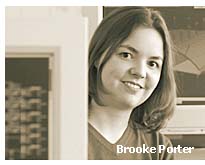


Making Their Mark
by Dan Kaempff
How’s this for an improbable situation: Imagine a student winning a full-ride master’s program scholarship to one of the finest universities in the nation.
That’s difficult
enough to accomplish in and of itself. But add the fact that the student in
question had never even heard of the discipline a scant four  years
before she won the scholarship. It sounds implausible, but that’s exactly
what Brooke Porter did. Porter, a 2000 Walla Walla College engineering graduate,
was awarded a National Science Foundation fellowship at Stanford University
in Palo Alto, Calif.
years
before she won the scholarship. It sounds implausible, but that’s exactly
what Brooke Porter did. Porter, a 2000 Walla Walla College engineering graduate,
was awarded a National Science Foundation fellowship at Stanford University
in Palo Alto, Calif.
The National Science Foundation (NSF) funds research and education in science and engineering. It does this through grants, contracts, and cooperative agreements to more than 2,000 colleges, universities, and other research and education institutions throughout the United States. The foundation accounts for approximately 20 percent of federal support to academic institutions for basic research.
Each year, NSF receives approximately 30,000 new or renewal support proposals for research, graduate and postdoctoral fellowships, and math/science/engineering education projects; it makes approximately 9,000 new awards.
The agency operates no laboratories itself, but does support National Research Centers, certain oceanographic vessels and Antarctic research stations. The foundation also supports cooperative research between universities and industry and participation in international scientific efforts.
Porter’s academic achievements take on more significance considering the fact that she hadn’t considered engineering as a career option until her senior year at Thunderbird Academy in Arizona. No one in the 21-year-old’s family is an engineer, and she couldn’t recall even meeting one or reading anything about the discipline. In fact, the first time she heard of engineering was through a career assessment test.
“I took the Strong-Campbell test, one of those tests that matches your academic and personal interests to potential careers,” Porter recalls. “The test results said engineering would be a good match for my skills and personality.”
It was an unexpected result for Porter. But not being one to make a hasty decision regarding her field of academics, Porter put engineering on her list of potential areas of academic study and headed off to Columbia Union College to study the humanities and explore her options. “I decided to just take a variety of courses at first, even though I had developed a strong interest in engineering,” she says. Toward the end of her sophomore year, she decided to enroll in the engineering program at WWC, but she still had an open mind regarding her career choice.
Her reason for choosing engineering showed a great deal of wisdom for a young person. Having talents in mathematics as well as writing, she made her decision based on what she felt was the best way to use her skills. “I knew math would not be as big a benefit in a career in the humanities, as writing would be in a scientific position,” she explains.
Knowing no one at WWC, she arrived in College Place with a slight amount of trepidation. However, she quickly made friends with fellow dorm dwellers. In addition, being one of the few females studying engineering, she found her fellow students more than willing to be pals. “The guys were very friendly,” she says with a laugh. “All in all, transferring to WWC wasn’t a big deal at all.”
Porter’s undergraduate grades earned her offers from several prestigious graduate programs including Stanford, MIT, Georgia Tech, and Cal Tech, all of which would have provided a solid education. After visiting the four schools, her final decision was between MIT and Stanford. Stanford won out thanks to reasons beside the fact that it is a top-notch university. “Stanford offered a more broadly based curriculum than the other schools I looked at,” Porter says. “I’m still in the process of deciding what I really want from engineering, so I liked the fact that I could explore options at Stanford. Plus, it’s a one-year program; unlike the others I looked at, which were two years. Also, I like the West Coast and I wanted to stay out here, near my friends.”
It’s without question that the master’s program at Stanford is intense. Porter’s days are long, filled with classes, research, and study. But she manages to find the time to serve others. She is involved in a program called “Henry’s Place,” working with fourth and fifth graders at a Palo Alto elementary school. The focus of the program is to make science fun and exciting to children, while at the same time providing some structure and mentoring that may be missing from a child’s life.
Come summer, she will hold a graduate degree in aerospace engineering. From there, the future is wide open. “I may pursue a Ph.D., but I think before I do that, I’d like to move to Southern California and work for a few years,” says Porter. “I’m just trying to be open and see where God is leading my life.”
Dan Kaempff, a 1987 communications graduate, lives in Tualatin, Ore.